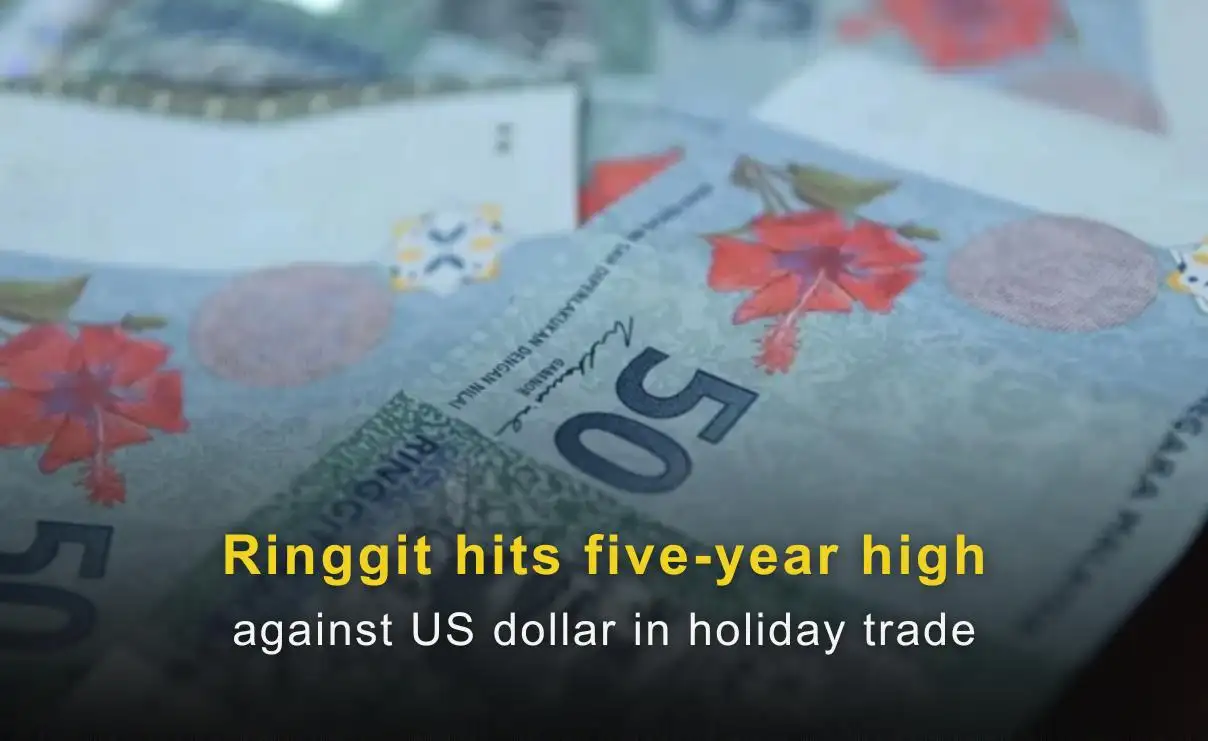Ringgit hits five-year high against US dollar in holiday trade
The Malaysian ringgit extended its rally, reaching a five-year high against the US dollar, trading in a narrow range of RM4.04-RM4.05.
简体中文
繁體中文
English
Pусский
日本語
ภาษาไทย
Tiếng Việt
Bahasa Indonesia
Español
हिन्दी
Filippiiniläinen
Français
Deutsch
Português
Türkçe
한국어
العربية
Abstract:The degree of a trader's trading discipline has a significant impact on their performance. 15% of forex traders break even, while 70% of them lose money. The remaining 15% of forex traders are lucrative because they maintain a consistent level of self-control.

The degree of a trader's trading discipline has a significant impact on their performance. 15% of forex traders break even, while 70% of them lose money. The remaining 15% of forex traders are lucrative because they maintain a consistent level of self-control.
In order to trade, you must make the law of averages work in your advantage.
In order to trade profitably, there is no fast route. A tested forex trading strategy must be used repeatedly in order for it to be effective enough to generate profits across a number of trades.
Simple math tells us that if we trade with discipline, we will prosper; if we trade without discipline, we will fail. Many inexperienced investors desire to quadruple their earnings in a matter of days or even weeks. They fail to understand, however, that forex trading is just like regular investing and not a get rich fast program.
A good thing to remember when trading Forex, is to also have a good broker. There are many scams out there and brokers seems to be one of the biggest reasons why traders fail. These dodgy brokers often hire “mentors” to help them recruit customers and further scam them. WikiFX allows you to clearly identify and understand which brokers are scammers and which arent. You can download the WikiFX app in the app store or play store. This will prevent you from getting scammed by any brokers.
I believe the following 10 principles will help you on your forex journey as they have helped me in my trading career:
1. Have an account with enough money in it
I think the most of us will begin trading on demo accounts for a while to test out our techniques. We will then go on to a real account once we are sure that our lucrative technique is working. Some people may use tiny amounts of money to test their trading strategies and emotions on actual accounts, and that is quite acceptable.
Here, though, is why I believe a well-funded account is important. A $100 funded account and a $5,000 financed account are compared.
Let's assume we achieve a 5% return for a month:
You get $5 from a $100 account.
Your $5000 account has $250.
The $100 account holder will often trade more aggressively when compared to the other because the rewards are not as satisfactory. Small account holders are therefore likely to feel pressured psychologically to make more deals. This action encourages risk-taking, which raises the likelihood of being stopped out in the end. As a result, the $100 account holder is more likely to burn their money.
However, the one making $250 may sense the influence of how trading can begin to enhance his or her way of life, without having to engage in excessive trading or risk-taking.
2. Never stake more than 5% of your capital on a single deal.
The key to effective risk management is to trade within the limits of your account. One common guideline is to never risk more than 5% of your cash. Since we do not have complete control over the market, we cannot consistently win all of our transactions. Instead, we should strive to conclude each month with net earnings in our account. You risk losing all of your profits from the previous month in a single transaction if you don't set a risk limit and stick to it, or even worse, you risk getting a margin call for a single trade that you overleveraged. Though several trading techniques necessitate various forms of risk control,
3. Avoid attempting to predict each market shift.
Keep your hands off the tops and bottoms! Near some significant market peaks and bottoms, you might wish to position yourself for counter-trend trades. To avoid missing out on any potential earnings, you could be tempted to enter at every transaction you see. Catching market tops and bottoms is like trying to halt a charging bull or bear in the hopes that it may reverse course. Sound dangerous? It is, indeed!
4. A trader's role is to respond, not to forecast.
Never try to forecast where the market is going; instead, as traders, we should watch for market indications or cues that point to the next move that could be conceivable. Our responsibility is to seize these opportunities and go along for the ride.
5. Avoid analysis until you get paralyzed
Many traders over-analyze their transactions, which causes them to delay and lose out on good trades. Before making a trade, some people wait for the ideal price to enter (which was never filled), while others wait for all the signs to be in their favor. I'm not advocating that we ignore our trading strategy.
I want to make it clear that you must learn to handle it because unless you make that exchange, you will never be in the right. Get out and cut your losses if you are mistaken.
6. Consistently follow your trading strategy
You are biased if you wish to sell or buy a certain pair because you have seen trade calls on websites or have heard from friends that the pair is overbought or oversold. You should always be on the lookout for confluence in our line of work. You should make the trade based on your own analysis if most or all of your criteria have been satisfied and there are technical evidences accessible.
7. Always follow the trend and apply top-down analysis
In this method, the weekly chart, typically, is the highest period that is constantly examined, and so on. Higher period trends are always stronger and more dependable than lower timeframe trends, support, and resistance. In order to increase the confluence for our trade likelihood, this aids us. Your risk is somewhat decreased if you see a slump in the weekly and daily timeframes and we are looking to short in the h1 timeframe since the general trend, even in the longer period, is not against you.
The adage “The trend is your friend” is one that I believe to be highly accurate. You may reduce your risk while maintaining momentum by going with the flow by following the trend.
8. If you go on a losing streak, keep going.
Always keep in mind that trading is much like other investments in that we want to make money over the long term. Losing streaks are common, but as long as your trading strategy has established itself, the odds will eventually turn in your favor. This leads me to my second argument, which is that even if one loses 60–70% of their trades, they may still turn a profit over time.
9. Maintain a profitable business.
To maintain profitability in your favor, make sure your deal has a favorable risk-to-reward ratio (RRR). If your aim is 120 pips and your stop loss is 40 pips, your risk-to-reward ratio is 1:3, giving you room to lose two more trades before you break even. I've come across a trader that only wins 35% of the time but consistently makes money each month. This is so because the risk he takes is always outweighed by his RRR by a wide margin.
10. Make a living as a bricklayer!
A bricklayer's job is to come to work each day and repeatedly lay bricks using the same technique. Likewise with trading. You have either risked too much of your cash or you still haven't learned to control your emotions to trade rationally if you're continually checking your trades every three minutes and can feel your heart beating rapidly every time you make a deal. You will achieve financial success by maintaining the same consistency in both your trading approach and execution plan.

Disclaimer:
The views in this article only represent the author's personal views, and do not constitute investment advice on this platform. This platform does not guarantee the accuracy, completeness and timeliness of the information in the article, and will not be liable for any loss caused by the use of or reliance on the information in the article.

The Malaysian ringgit extended its rally, reaching a five-year high against the US dollar, trading in a narrow range of RM4.04-RM4.05.

WikiFX has launched the “Inside the Elite” Interview Series, featuring outstanding members of the newly formed Elite Committee. During the committee’s first offline gathering in Dubai, we conducted exclusive interviews and gained deeper insights into regional market dynamics and industry developments. Through this series, WikiFX aims to highlight the voices of professionals who are shaping the future of forex trading — from education and compliance to risk control, technology, and trader empowerment.

The U.S. National Futures Association (NFA) has filed charges against Forex Wizard, a Japan-based forex trading operation, and its principal Mitsuaki Kataoka, accusing them of failing to process customer withdrawal requests promptly.
Dear Members, WikiFX offers its warmest holiday wishes to you. May each day be filled with peace and joy, and may you share meaningful moments with your family and friends during this festive season. As a global leading forex investment ecosystem service platform, WikiFX has, for over a decade, remained committed to improving trading security, enhancing industry transparency, and protecting investor rights.
